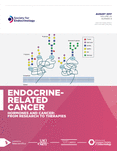TERT promoter mutations and long-term survival in patients with thyroid cancer
- Tae Hyuk Kim1,*,
- Young-Eun Kim2,*,
- Soomin Ahn3,*,
- Ji-Youn Kim4,
- Chang-Seok Ki5,
- Young Lyun Oh3,
- Kyunga Kim6,
- Jae Won Yun7,8,
- Woong-Yang Park7,8,
- Jun-Ho Choe9,
- Jung-Han Kim9,
- Jee Soo Kim9,
- Sun Wook Kim1 and
- Jae Hoon Chung1⇑
- 1Division of Endocrinology and Metabolism, Department of Medicine, Thyroid Center, Samsung Medical Center, Sungkyunkwan University School of Medicine, Seoul, Korea
- 2Green Cross Genome, Yongin, Korea
- 3Department of Pathology, Samsung Medical Center, Sungkyunkwan University School of Medicine, Seoul, Korea
- 4Center for Clinical Medicine, Samsung Biomedical Research Institute, Samsung Medical Center, Seoul, Korea
- 5Department of Laboratory Medicine and Genetics, Samsung Medical Center, Sungkyunkwan University School of Medicine, Seoul, Korea
- 6Biostatistics and Clinical Epidemiology Center, Research Institute for Future Medicine, Samsung Medical Center, Sungkyunkwan University School of Medicine, Seoul, Korea
- 7Samsung Genome Institute, Samsung Medical Center, Seoul, Korea
- 8Department of Molecular Cell Biology, Sungkyunkwan University School of Medicine, Suwon, Korea
- 9Division of Breast and Endocrine Surgery, Department of Surgery, Samsung Medical Center, Sungkyunkwan University School of Medicine, Seoul, Korea
- Correspondence should be addressed to J H Chung; Email: thyroid{at}skku.edu
-
Figure 1
Kaplan–Meier curves of thyroid cancer-specific survival by TERT mutational status. Results from the analysis of patients with (A) differentiated thyroid cancer and (B) papillary thyroid cancer. A full colour version of this figure is available at http://dx.doi.org/10.1530/ERC-16-0219.
-
Figure 2
Kaplan–Meier curves of thyroid cancer-specific survival by four genotypes according to the TERT and BRAF mutational status. Results from the analysis of patients with papillary thyroid cancer. A full colour version of this figure is available at http://dx.doi.org/10.1530/ERC-16-0219.
- © 2016 Society for Endocrinology












